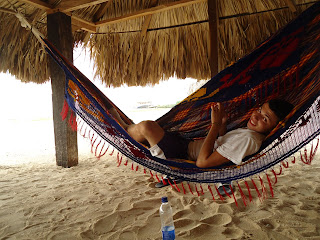Imagine racing down a three story sand dune to dive right into the ocean on a remote beach with no one else around for miles. Actually, I was making giant astronaut moon jumps, and Alex rolled down sideways, but you get the picture. An afternoon at Taroa beach made everything getting there worth it. It's exhilarating!
We traveled quite a bit that morning to get there. First, Jorge picked us up at about 5 to take us to Puerto Bolivar, near El Cerrejon coal mine. Then, we took a boat Punta Gallinas, through the Bahia Hondita, which took a couple of hours. Once we docked, we climbed a ridge to a small group of houses. There we met Fransisco, the owner of Kai tours, which is a pioneer in ecotourism in the Upper Guajira. Kai offers excursions to Cabo de La vela/Punta Gallinas by building good relations with the Wayuu. Over breakfast he gave us a rough idea of things we could do in the morning before we went to the dunes later in the evening. There were four other travelers there, a couple from Cali, and two ladies from Holland, Marieke and Adriadne. They were going to another beach and would join us later.
Alex and I decided to take a walk around the bay and dunes around the tiny village. It was a burnt orange rocky landscape with rich green vegetation here and there. There were piles of bleached conch shells everywhere. It was very quiet, aside from the wind and the occasional chiva (goat). We made it out to the sand dunes across the bay from the village. Our walk was was incredibly beautiful, but the heat was brutal. We were only out for a couple of hours before we headed back and passed put on our hammocks. Throughout the day, fishermen came to the village to sell fish and lobster.
After lunch, Francisco and four of us got on the back of a truck for a drive out to the dunes of Taroa beach. On the way, we stopped at the Punta Gallinas lighthouse. We spent a spectacular two hours just taking everything in at Taroa. Then we walked the dunes as Francisco told us a bit about the Wayuu and the environment. A while later, we sat down on a dune and watched the sun set.
That night, over a fresh lobster dinner, Francisco mentioned that there was a conservation project in Punta Gallinas to save turtles that migrate to the area to lay eggs. Fishermen roam the beaches at night looking for the giant turtles to come ashore. If one was spotted, they would call Fransisco and we could go see the turtle, and watch them record the number, weight, and diameter of any eggs that were laid (and 45 days from now, visitors can go see the hatchlings). The girls had gone the night before. Unfortunately, none came ashore that night.
The next day, we were up early to begin the day long trip back to Santa Marta.
When you have no idea what time it is, you get up when the sun does. I think this was about 4 am.
Our ride to Punta Gallinas
Through the Bahia Hondita
Taking a break from the sun, before we go out for our walk
Dinner
On our way to the beach with Marieke and Adriadne
A Wayuu village
Punta Gallinas Lighthouse
Finally, the dunes
The pristine Playa Taroa
The sunsets are beautiful.
- Posted using BlogPress from my iPad

























































